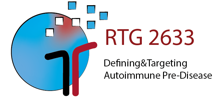MD A4: Do interactions between AT1R autoantibodies derived from patients with systemic sclerosis and endothelial cells lead to endothelial dysfunction?
Autoantibodies directed against angiotensin II type I receptor (AT1R) are a feature of systemic sclerosis (SSc) and have been linked to pathophysiological events such as vascular alterations. Further, it is postulated that interactions between G protein-coupled receptors (GPCR) antibodies and endothelial cells contribute to the pathogenesis of SSc. The proteins and lipids of the outer membrane of endothelial cells are often linked to carbohydrates that protrude into the extracellular space and in their entirety form the so-called glycocalyx. Structural changes in the glycocalyx of endothelial cells are linked to cellular function. It has been shown that proinflammatory cytokines can alter the glycocalyx. However, not much is known about the effects of GPCR autoantibodies such as AT1R autoantibodies on the endothelial glycocalyx (eGC). If interactions between AT1R autoantibodies and AT1R expressed by endothelial cells induce changes in the glycocalyx, this would indicate a functional relevance of AT1R autoantibodies in the pathogenesis of SSc. Anti-AT1R IgG will be obtained from serum samples of patients with SSc (n=10) using protein G chromatography. Sera are selected on the basis of disease activity (EUSTAR activity score), organ involvement and the presence of a high AT1R antibody titer. To examine interactions between the eGC and GPCR autoantibodies as well as cytokines, shown to play a role in SSc, atomic force microscopy (AFM) at the Institute of Physiology will be applied. AFM can be used to resolve surfaces and physical properties on the nanoscale and therefore determine which of the possible conformations of the eGC predominates. Using AFM, the structure of the glycocalyx will be assessed after stimulation of the cells. In vitro experiments will be performed in which human umbilical vein endothelial cells are stimulated with (i) sera (SSc, n=4 vs. HC pool), (ii) IgG (SSc-IgG pool in combination with Angiotensin II, the AT1R antagonist Losartan and IL-6, and (iii) recombinant AT1R autoantibody compared to isotype control in combination with losartan.

- Projects
- A: Defining Autoimmune Pre-Disease
- B: Targeting of Autoimmune Pre-Disease
- Associated projects
- MD projects
- Associated MD projects
- Concluded Projects
- PhDs
- Ass. projects
- MDs
- MD A1 - Investigation of the influence of specific CDK inhibitors on neutrophil activation
- MD A2 - Conception of an anatomical expression of landscape of target antigens in autoimmune blistering dermatoses as markers for lesion formation
- MD A3 - Structural characterization of skin-directed autoantibodies and their interaction with the antigen to gain insights into autoimmune pre-disease
- MD A4 - Do interactions between AT1R autoantibodies derived from patients with systemic sclerosis and endothelial cells lead to endothelial dysfunction?
- MD A5 - Optimization and exploitation of a 3D model of human skin for translational use
- MD A6- To study vasculopathy in systemic sclerosis
- MD A7- Identification of autoantibodies contributing to the break of immunotolerance in immunization induced MMP mouse model
- MD A8- The role of AT1R antibodies and extracellular vesicles in mediating endothelial dysfunction in systemic sclerosis with pulmonary arterial hypertension
- MD A9- Impact of glycosylation on IgG4-induced signaling in neutrophils
- MD A10- Testing a new single chain variable fragment for pemphigus foliaceus in the human skin organ culture model
- MD A11- Impact of glycosylation on IgG3-induced signaling in neutrophiles
- MD A12- Screening for inhibitors to prevent keratinocytes dissoziation
- MD A13- Investigation of the local and systemic complement activation in bullous pemphigoid
- MD A14 - Impact of different subclasses on immune complex-induced signaling in neutrophils.
- MD A15 - Novel target antigens as inducers of autoimmunity of autoimmune bullous dermatoses
- MD A16 - Identification of the major epitope of the BP180 ectodomain recognized by serum IgA autoantibodies of patients with pemphigoid diseases –IgA autoantibodies as prognostic marker?
- MD B1 - Testing the effect of kinase inhibitors in the human skin organ culture model
- MD B2 - Cigarette smoking-induced autoantibodies
- MD B3 - Contribution of taurine, hypoxanthine, vitamin B5 and B6 in the pathomechanism of pemphigus vulgaris
- MD B5 - Molecular characterization of the pre-autoimmune effects of Western diet in healthy mice
- Ass MDs








